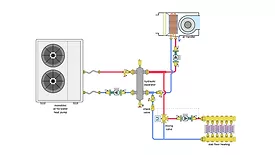Home » Keywords: » hydronic heating
Items Tagged with 'hydronic heating'
ARTICLES
The Glitch & The Fix: April 2025
Consider the “dual temperature” heat pump system shown in figure 1
Read More
Renewable Heating Design | John Siegenthaler
Versatility in direct-to-load systems, part one
Going direct.
March 12, 2025
Heating Perceptions | Scott Secor
Old home needs entirely new heating system; is it worth it?
Exploded radiators
March 10, 2025
Hydronics Workshop | John Siegenthaler
Be prepared to advocate for hydronic-based heat pump systems
Different strokes.
March 9, 2025
Renewable Heating Design | John Siegenthaler
When one heat pump isn’t enough — part two
Simultaneous heating and cooling with multiple heat pumps.
February 12, 2025
Hydronics Workshop | John Siegenthaler
Heat pumps open possibilities for DWH and hydronic-based cooling
Expanding a concept — part two.
February 4, 2025
Heating Perceptions | Scott Secor
Low-pressure steam boiler piping gets much-needed replacement
71-year-old piping failure at an apartment complex resulted in many challenges.
January 8, 2025
Renewable Heating Design | John Siegenthaler
When one heat pump isn’t enough
Part one.
January 7, 2025
Duel-fuel solution offers best of both worlds
Hydronic electrification leverages residential solar.
January 7, 2025
Hydronics Workshop | John Siegenthaler
Adding functionality to heat pump systems
Expanding a concept — part one.
January 2, 2025
Keep your content unclogged with our newsletters!
Stay in the know on the latest plumbing & piping industry trends.
JOIN TODAY!Copyright ©2025. All Rights Reserved BNP Media.
Design, CMS, Hosting & Web Development :: ePublishing












